Four-Quadrant Riemann Problem for a 2 × 2 System Involving Delta Shock
Abstract
1. Introduction
This is a restricted assumption for systems because an system can generally develop n waves at each initial discontinuity. Most of the RPs citations below were done without the above assumption .(H) Outside a neighborhood of the origin, each jump of the initial data projects exactly one plane elementary wave.
2. Preliminaries
3. Construction of the Solution
3.1. Two Delta Shocks
3.1.1. No Shock Wave
3.1.2. One Shock Wave
3.1.3. Two Shock Waves
3.2. One Delta Shock
3.2.1. No Shock Wave
3.2.2. One Shock Wave
3.2.3. Two Shock Waves
Author Contributions
Funding
Acknowledgments
Conflicts of Interest
References
- Korchinski, D.J. Solutions of a Riemann Problem for a 2 × 2 System of Conservation Laws Possessing No Classical Weak Solutions. Ph.D. Thesis, Adelphi University, New York, NY, USA, 1977. [Google Scholar]
- Zhang, T.; Zheng, Y.X. Conjecture on the structure of solutions of the Riemann problem for two-dimensional gas dynamics systems. SIAM J. Math. Anal. 1990, 21, 593–630. [Google Scholar] [CrossRef]
- Tan, D.C.; Zhang, T. Two-dimensional Riemann problem for a hyperbolic system of nonlinear conservation laws: I. four-J cases. J. Differ. Equ. 1994, 111, 203–254. [Google Scholar] [CrossRef]
- Tan, D.C.; Zhang, T. Two-dimensional Riemann problem for a hyperbolic system of nonlinear conservation laws: II. Initial data involving some rarefaction waves. J. Differ. Equ. 1994, 111, 255–282. [Google Scholar] [CrossRef]
- Tan, D.C.; Zhang, T.; Chang, T.; Zheng, Y. Delta-shock waves as limits of vanishing viscosity for hyperbolic systems of conservation laws. J. Differ. Equ. 1994, 112, 1–32. [Google Scholar] [CrossRef]
- Pang, Y.; Tian, J.P.; Yang, H. Two-dimensional Riemann problem for a hyperbolic system of conservation laws in three pieces. Appl. Math. Comput. 2012, 219, 1695–1711. [Google Scholar] [CrossRef]
- Pang, Y.; Tian, J.P.; Yang, H. Two-dimensional Riemann problem involving three J’s for a hyperbolic system of nonlinear conservation laws. Appl. Math. Comput. 2013, 219, 4614–4624. [Google Scholar] [CrossRef]
- Shen, C. Riemann problem for a two-dimensional quasilinear hyperbolic system. Electron. J. Differ. Equ. 2015, 2015, 1–13. [Google Scholar]
- Zhang, P.; Li, J.; Zhang, T. On two-dimensional Riemann problem for pressure-gradient equations of the Euler system. Discret. Contin. Dyn. Syst. 1998, 4, 609–634. [Google Scholar] [CrossRef]
- Shen, C.; Sun, M. The Riemann problem for the pressure-gradient system in three pieces. Appl. Math. Lett. 2009, 22, 453–458. [Google Scholar] [CrossRef][Green Version]
- Sheng, W.; Zhang, T. The Riemann Problem for the Transportation Equations in Gas Dynamics; American Mathematical Soc.: Providence, RI, USA, 1999; Volume 654. [Google Scholar]
- Cheng, H.; Liu, W.; Yang, H. Two-dimensional Riemann problems for zero-pressure gas dynamics with three constant states. J. Math. Anal. Appl. 2008, 343, 127–140. [Google Scholar] [CrossRef][Green Version]
- Wang, G.; Chen, B.; Hu, Y. The two-dimensional Riemann problem for Chaplygin gas dynamics with three constant states. J. Math. Anal. Appl. 2012, 393, 544–562. [Google Scholar] [CrossRef]
- Chen, T.; Qu, A. Two-dimensional Riemann problem for Chaplygin gas dynamics in four pieces. J. Math. Anal. Appl. 2017, 448, 580–597. [Google Scholar] [CrossRef]
- Shearer, M. The Riemann problem for 2 × 2 systems of hyperbolic conservation laws with case I quadratic nonlinearities. J. Differ. Equations 1989, 80, 343–363. [Google Scholar] [CrossRef]
- Andrianov, N.; Warnecke, G. On the solution to the Riemann problem for the compressible duct flow. SIAM J. Appl. Math. 2004, 64, 878–901. [Google Scholar]
- Yang, H. Generalized plane delta-shock waves for n-dimensional zero-pressure gas dynamics. J. Math. Anal. Appl. 2001, 260, 18–35. [Google Scholar] [CrossRef]
- Hwang, W.; Lindquist, W.B. The 2-dimensional Riemann problem for a 2 × 2 hyperbolic conservation law I. Isotropic media. SIAM J. Math. Anal. 2002, 34, 341–358. [Google Scholar] [CrossRef]
- Hwang, W.; Lindquist, W.B. The 2-dimensional Riemann problem for a 2 × 2 hyperbolic conservation law II. Anisotropic media. SIAM J. Math. Anal. 2002, 34, 359–384. [Google Scholar] [CrossRef]
- Isaacson, E.L. Global solution of a Riemann Problem for a Non-Strictly Hyperbolic System of Conservation Laws Arising in Enhanced Oil Recovery; Enhanced Oil Recovery Institute, University of Wyoming: Laramie, WY, USA, 1989. [Google Scholar]
- Keyfitz, B.L.; Kranzer, H.C. A system of non-strictly hyperbolic conservation laws arising in elasticity theory. Arch. Ration. Mech. Anal. 1980, 72, 219–241. [Google Scholar] [CrossRef]
- Temple, B. Global solution of the Cauchy problem for a class of 2 × 2 nonstrictly hyperbolic conservation laws. Adv. Appl. Math. 1982, 3, 335–375. [Google Scholar] [CrossRef]
- Sun, M. Construction of the 2D Riemann solutions for a nonstrictly hyperbolic conservation law. Bull. Korean Math. Soc. 2013, 50, 201–216. [Google Scholar] [CrossRef]
- Shen, C.; Sun, M.; Wang, Z. Global structure of Riemann solutions to a system of two-dimensional hyperbolic conservation laws. Nonlinear Anal. 2011, 74, 4754–4770. [Google Scholar] [CrossRef]
- Li, S.; Shen, C. Measure-Valued Solutions to a Non-Strictly Hyperbolic System with Delta-Type Riemann Initial Data. Int. J. Nonlinear Sci. Numer. Simul. 2020, 21, 1. [Google Scholar] [CrossRef]
- Hwang, J.; Shin, M.; Shin, S.; Hwang, W. Two dimensional Riemann problem for a 2 × 2 system of hyperbolic conservation laws involving three constant states. Appl. Math. Comput. 2018, 321, 49–62. [Google Scholar] [CrossRef]
- Keyfitz, B.L.; Kranzer, H.C. Spaces of weighted measures for conservation laws with singular shock solutions. J. Differ. Equ. 1995, 118, 420–451. [Google Scholar] [CrossRef]
- Li, J.; Zhang, T.; Yang, S. The Two-Dimensional Riemann Problem in Gas Dynamics; Longman; Chapman and Hall/CRC: Boca Raton, FL, USA, 1998; Volume 98. [Google Scholar]
- Kurganov, A.; Lin, C.T. On the reduction of numerical dissipation in central-upwind schemes. Commun. Comput. Phys. 2007, 2, 141–163. [Google Scholar]
- Shin, M.; Shin, S.; Hwang, W. A treatment of contact discontinuity for central upwind scheme by changing flux functions. J. Korean Soc. Ind. Appl. Math. 2013, 17, 29–45. [Google Scholar] [CrossRef][Green Version]


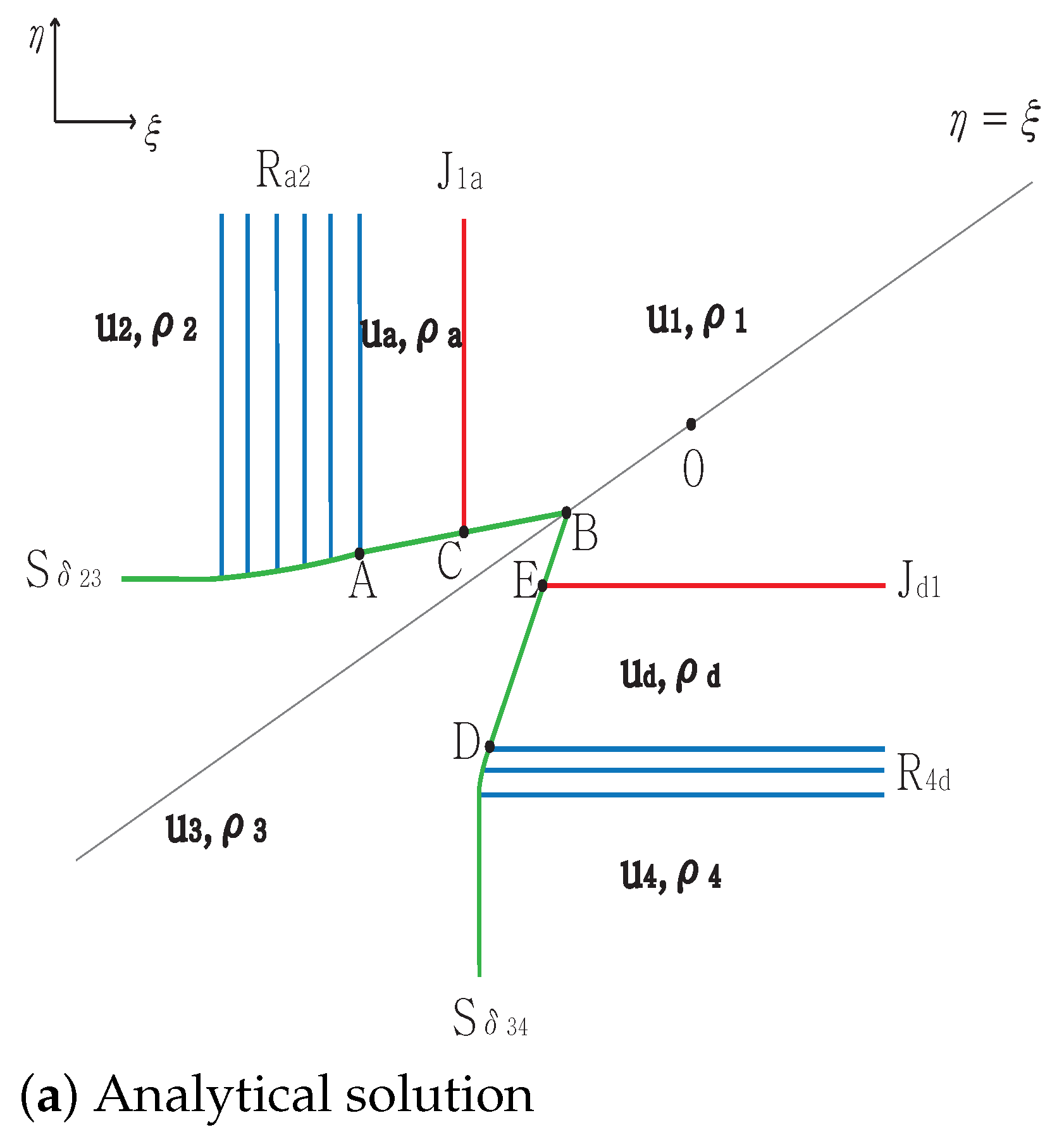
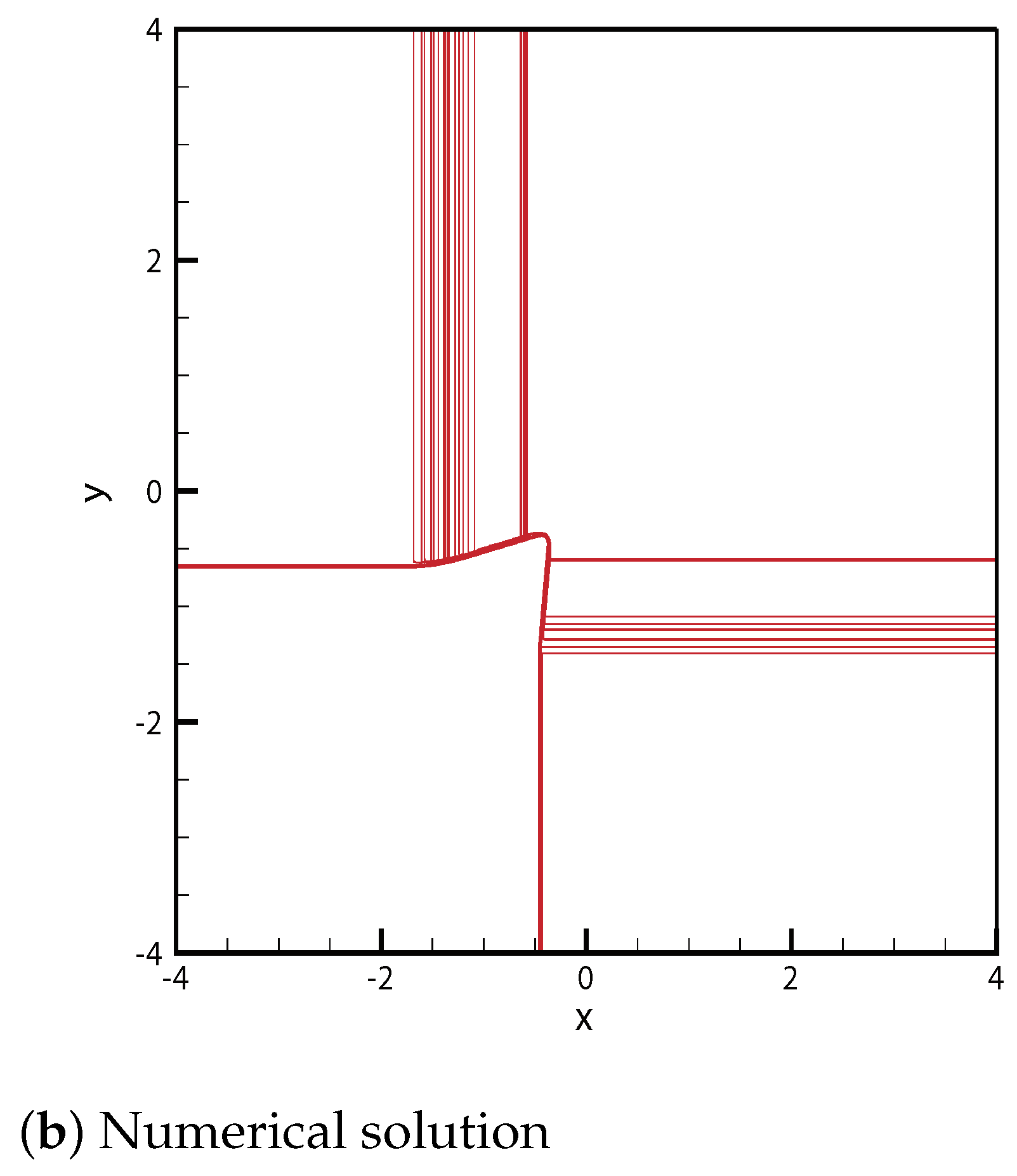
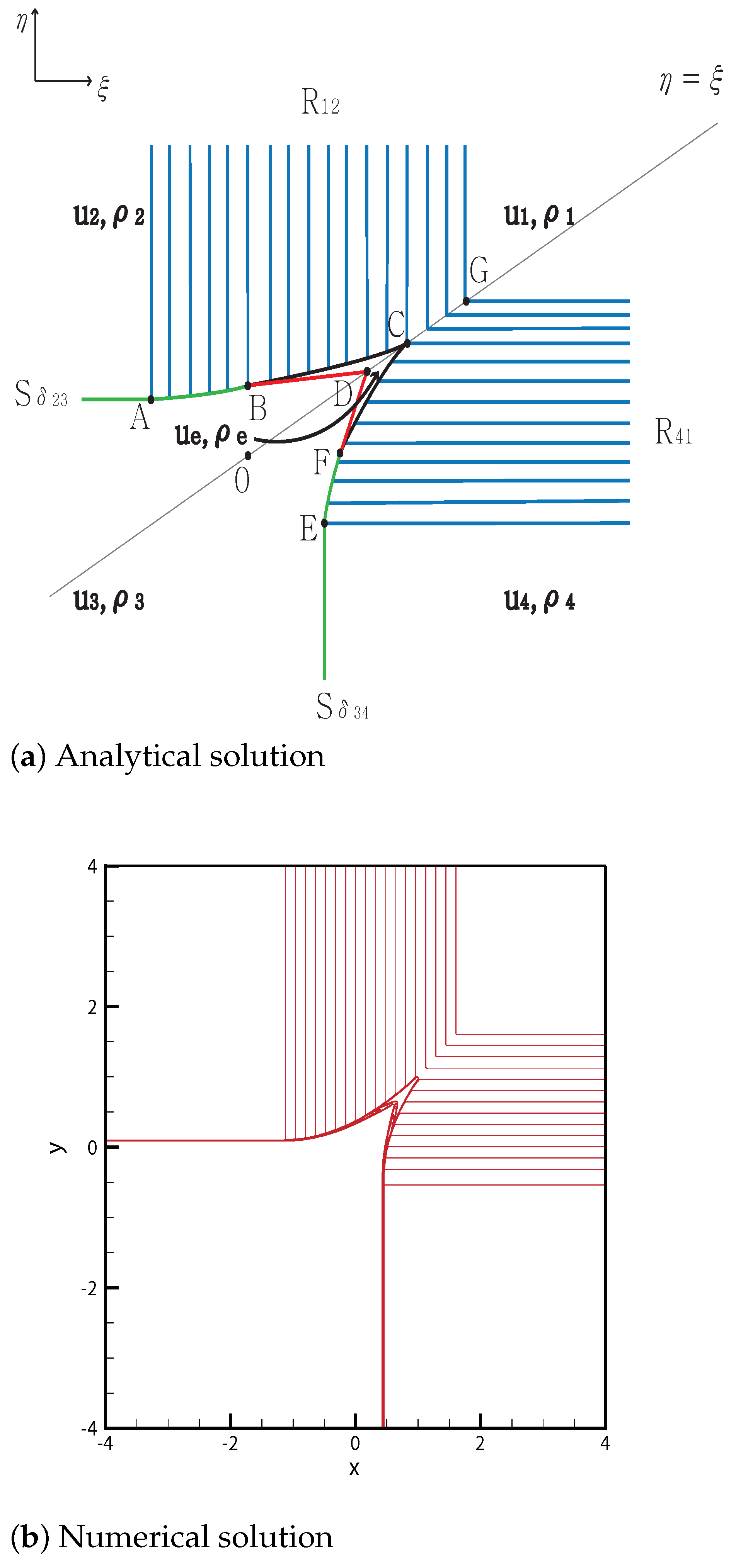
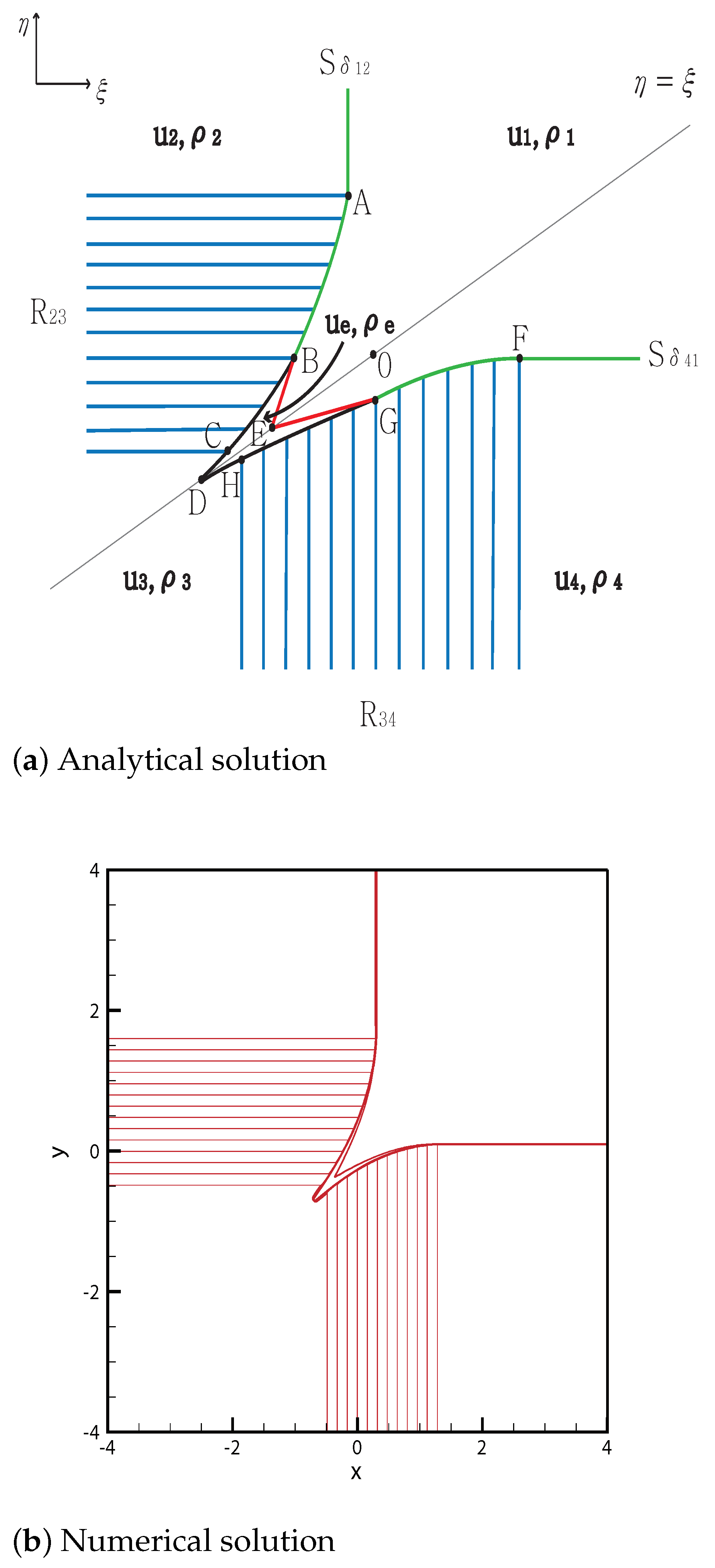
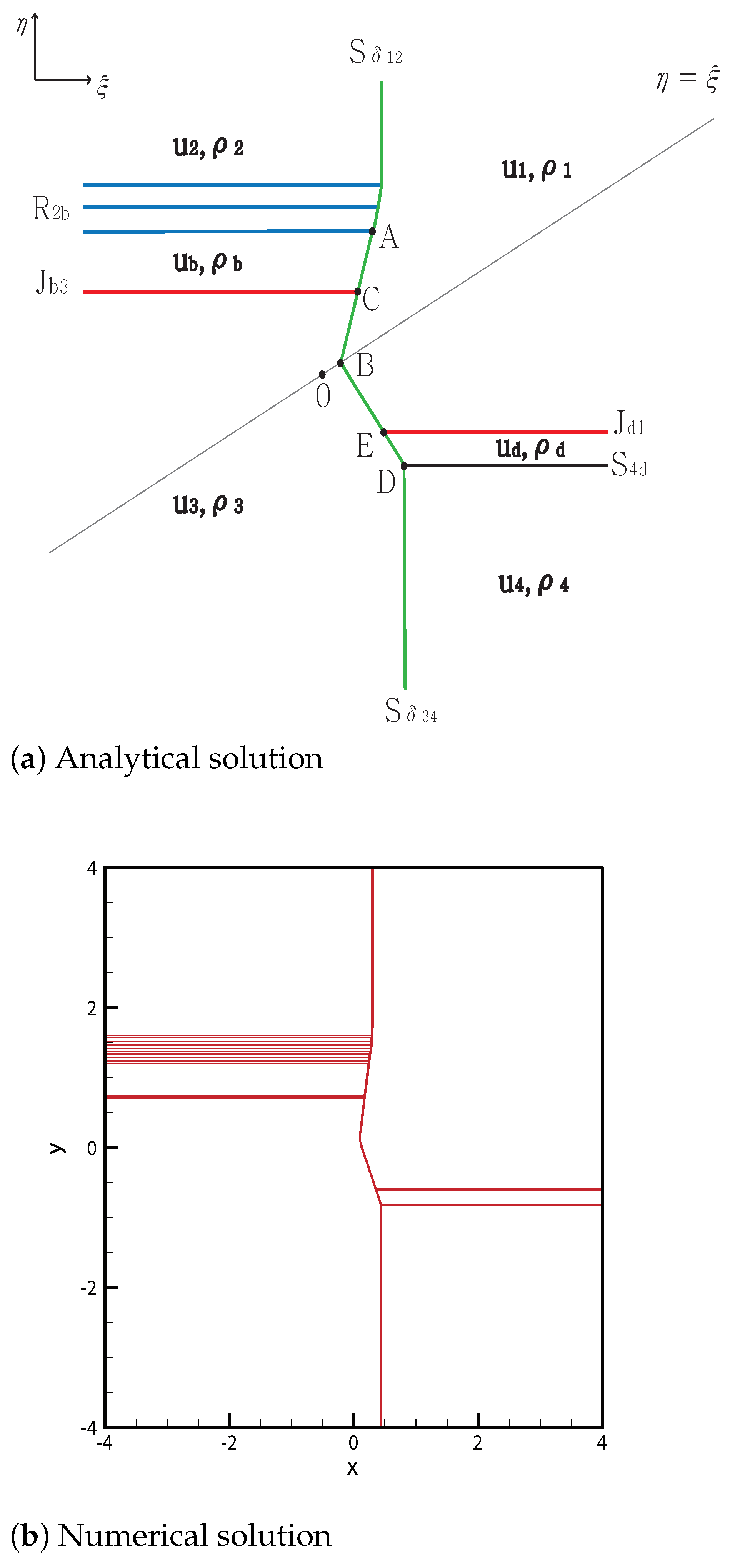
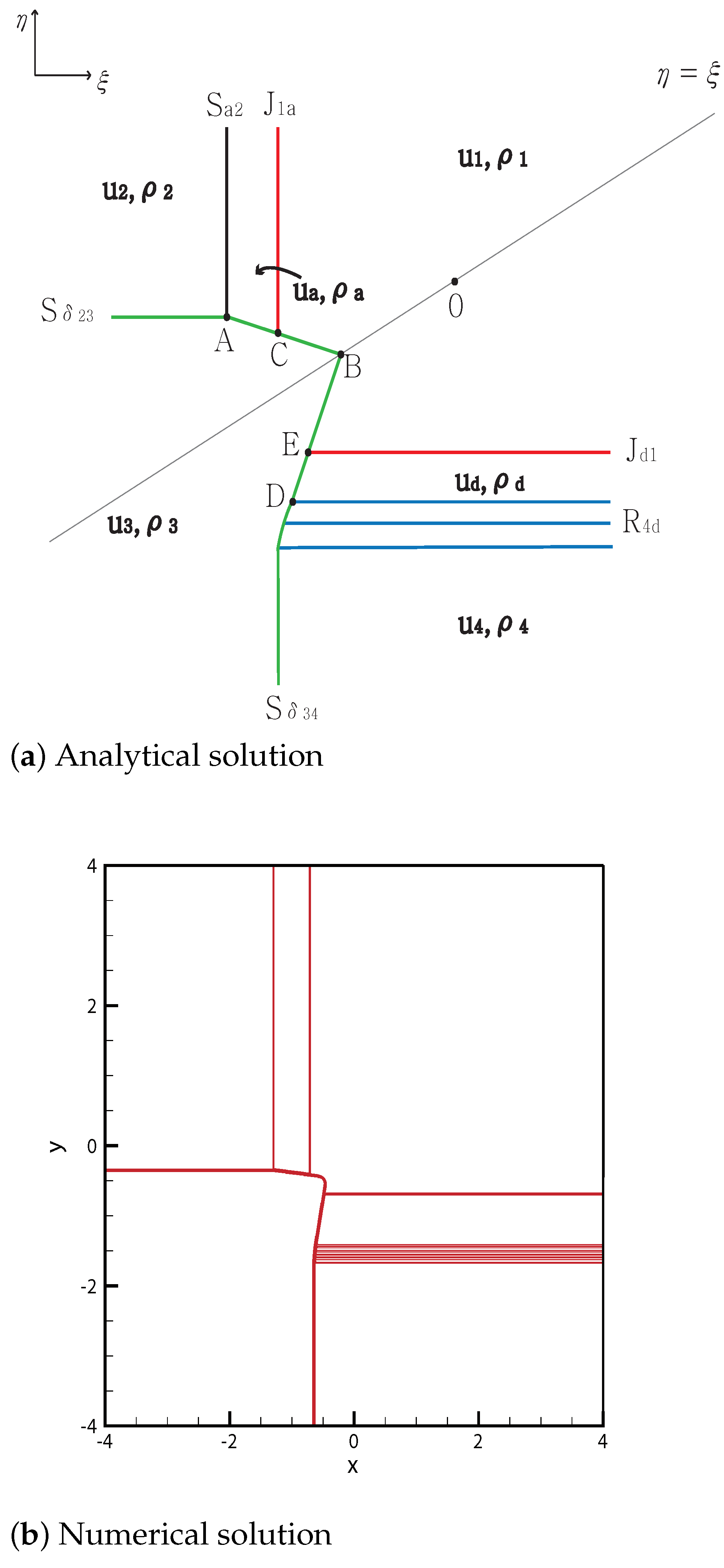
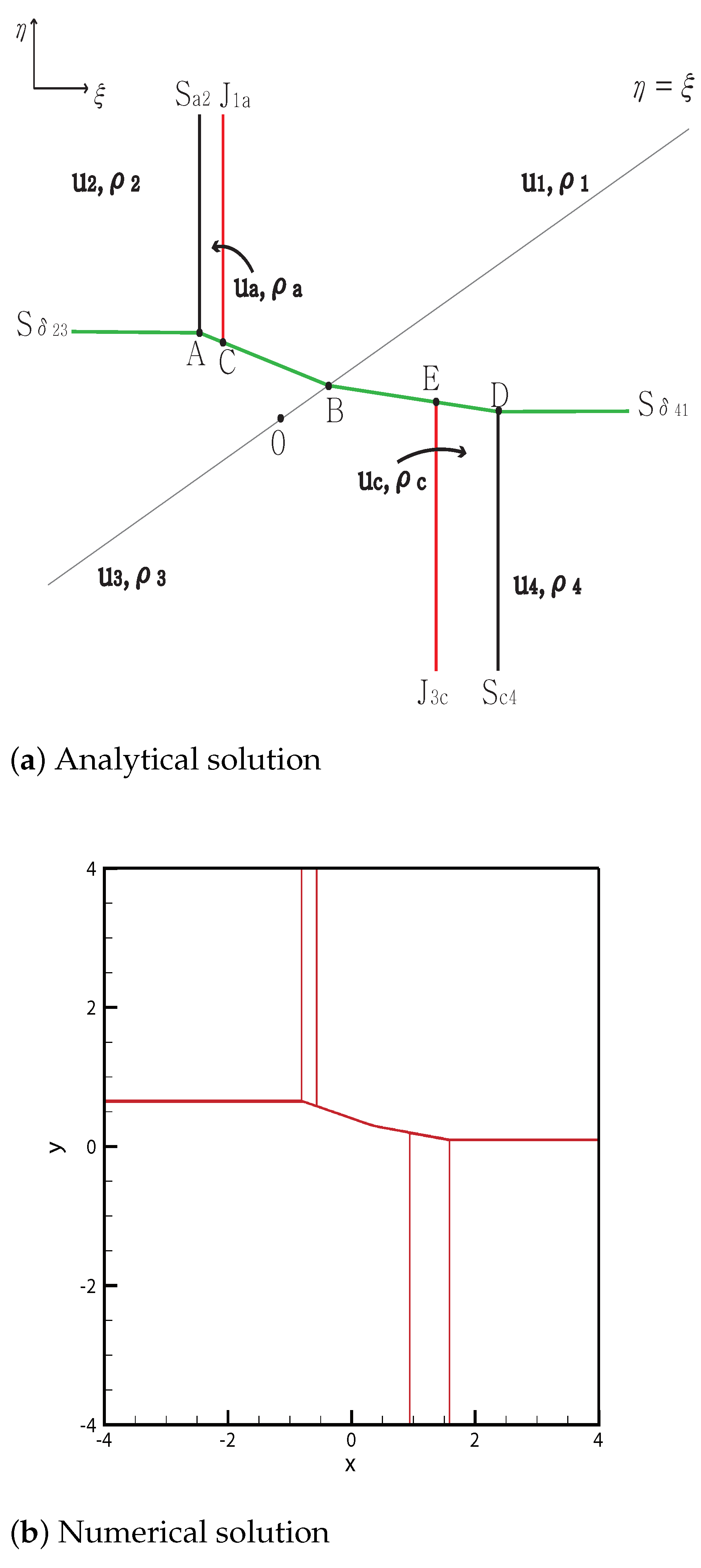
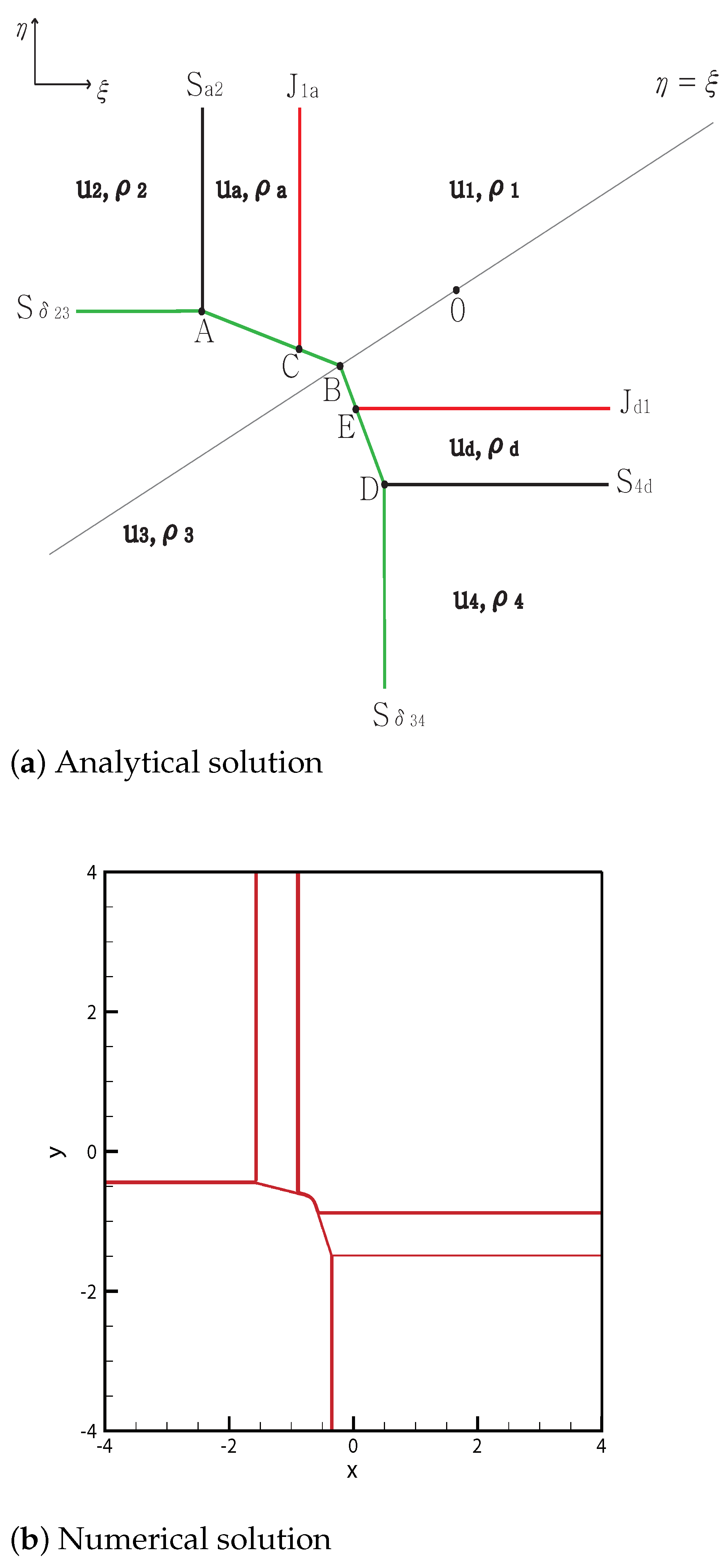
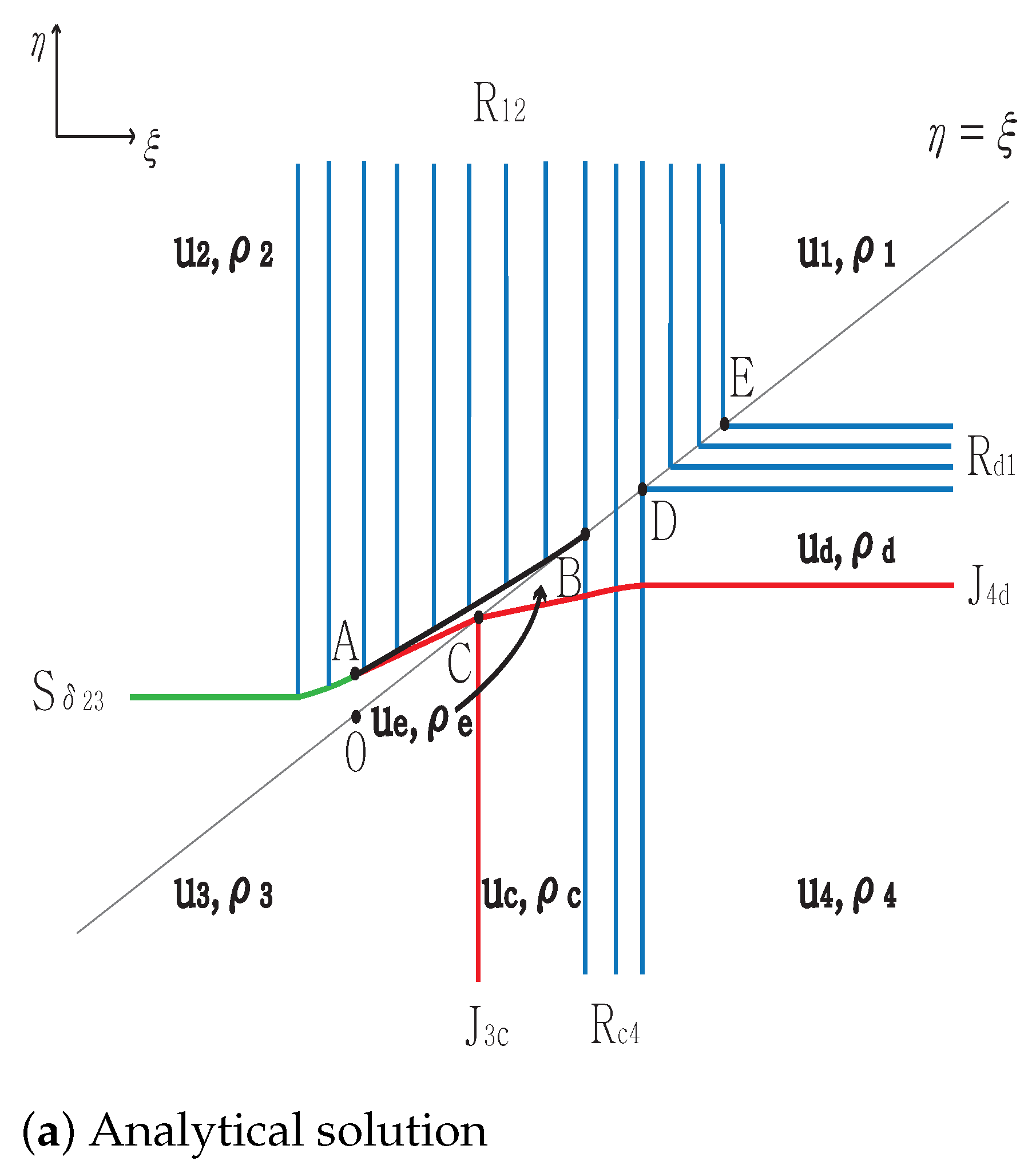
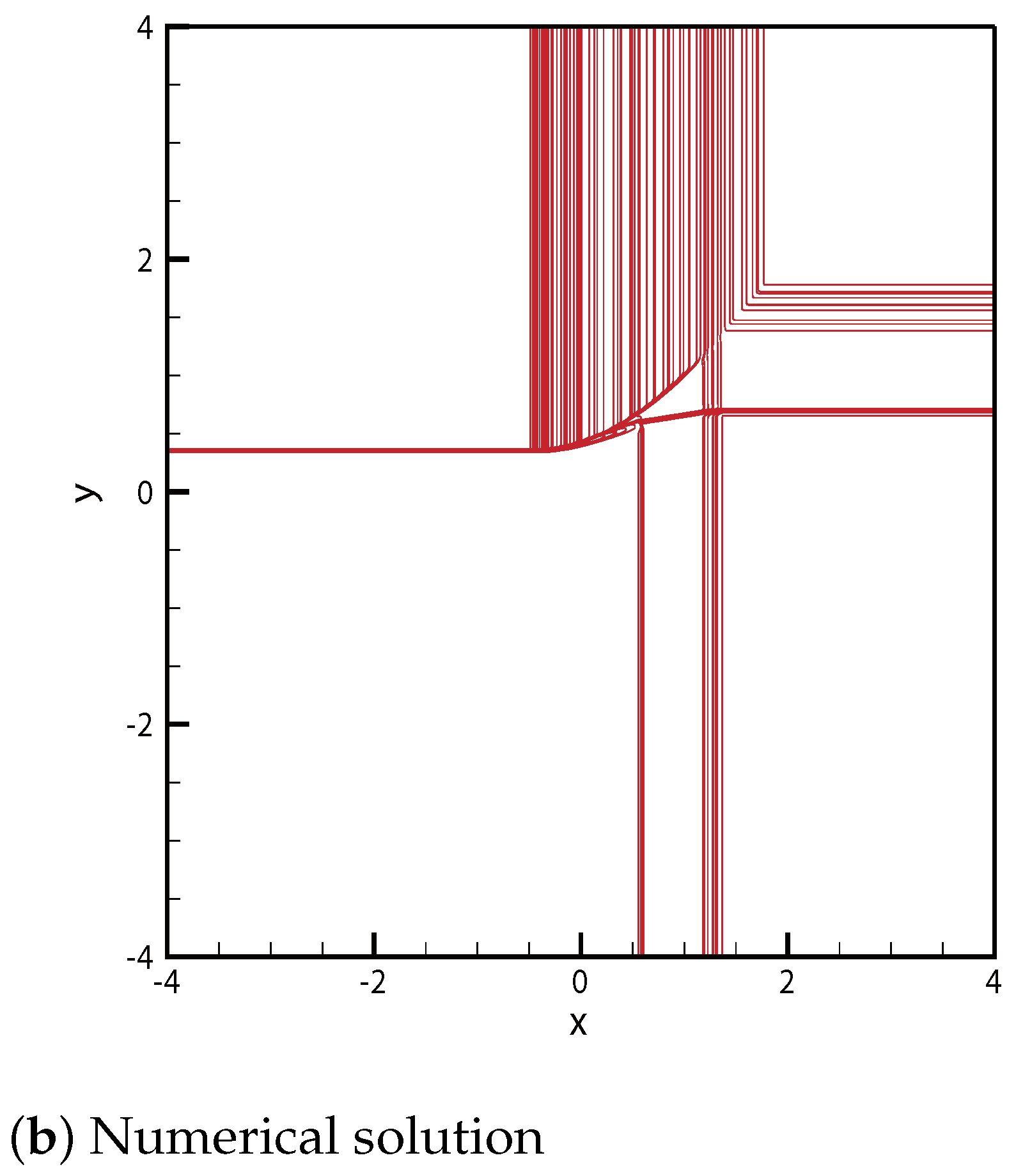


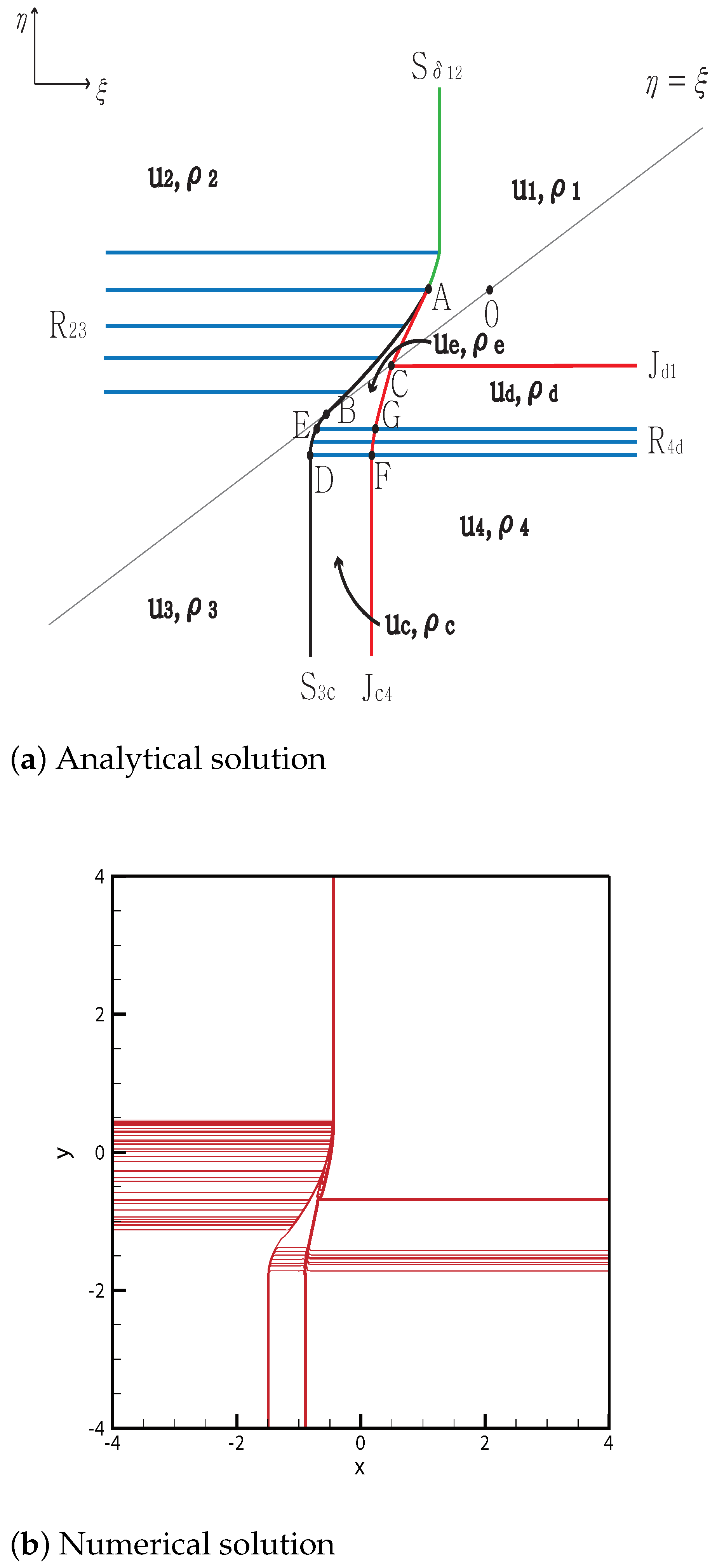
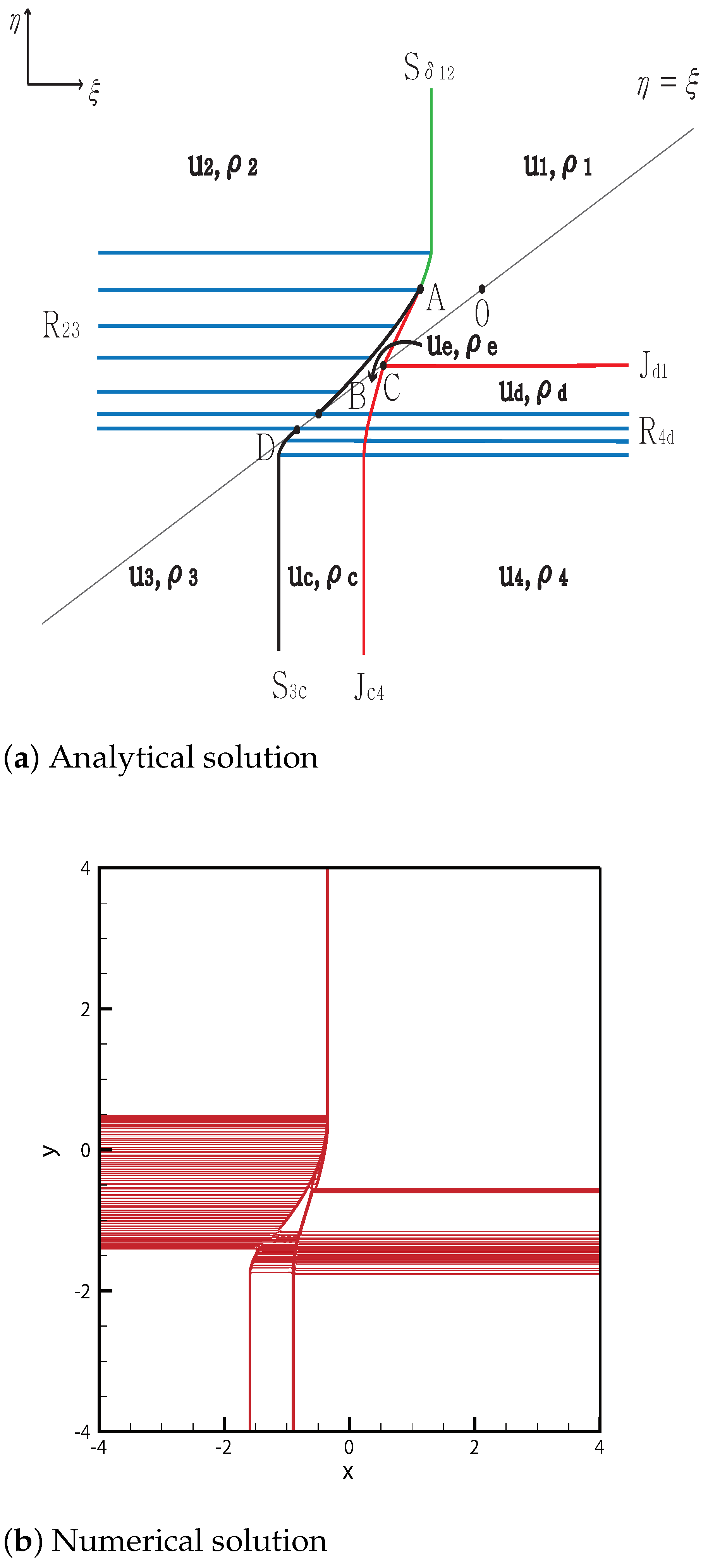

Publisher’s Note: MDPI stays neutral with regard to jurisdictional claims in published maps and institutional affiliations. |
© 2021 by the authors. Licensee MDPI, Basel, Switzerland. This article is an open access article distributed under the terms and conditions of the Creative Commons Attribution (CC BY) license (http://creativecommons.org/licenses/by/4.0/).
Share and Cite
Hwang, J.; Shin, S.; Shin, M.; Hwang, W. Four-Quadrant Riemann Problem for a 2 × 2 System Involving Delta Shock. Mathematics 2021, 9, 138. https://doi.org/10.3390/math9020138
Hwang J, Shin S, Shin M, Hwang W. Four-Quadrant Riemann Problem for a 2 × 2 System Involving Delta Shock. Mathematics. 2021; 9(2):138. https://doi.org/10.3390/math9020138
Chicago/Turabian StyleHwang, Jinah, Suyeon Shin, Myoungin Shin, and Woonjae Hwang. 2021. "Four-Quadrant Riemann Problem for a 2 × 2 System Involving Delta Shock" Mathematics 9, no. 2: 138. https://doi.org/10.3390/math9020138
APA StyleHwang, J., Shin, S., Shin, M., & Hwang, W. (2021). Four-Quadrant Riemann Problem for a 2 × 2 System Involving Delta Shock. Mathematics, 9(2), 138. https://doi.org/10.3390/math9020138




